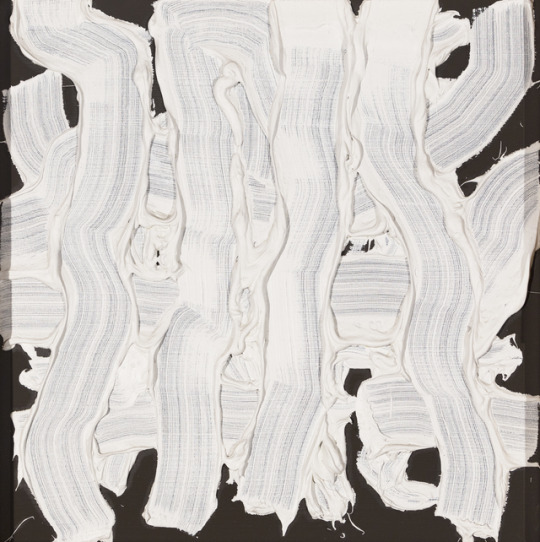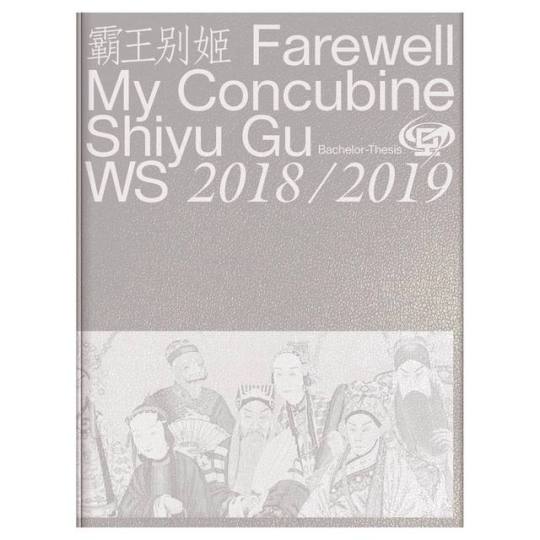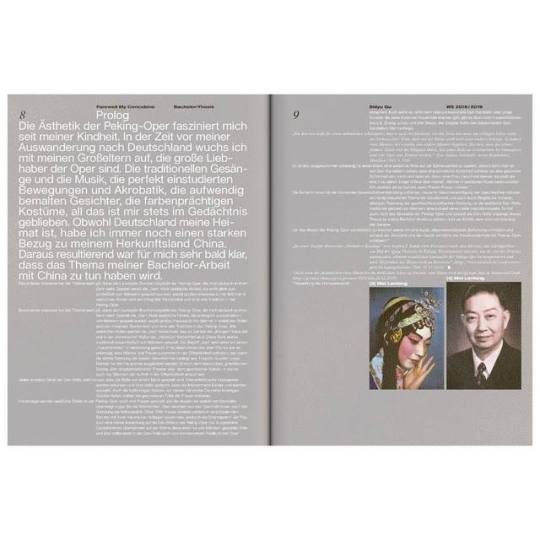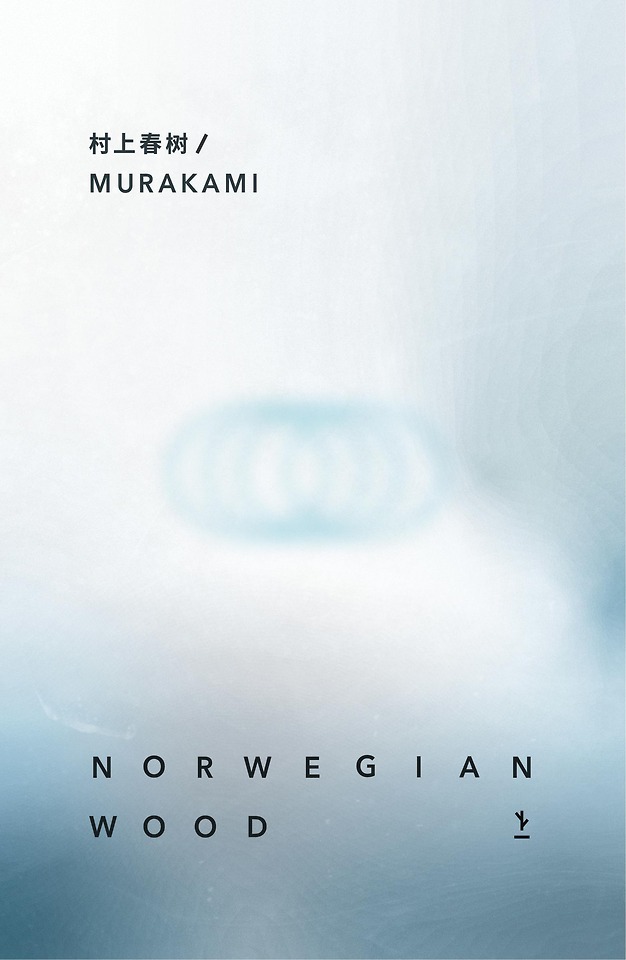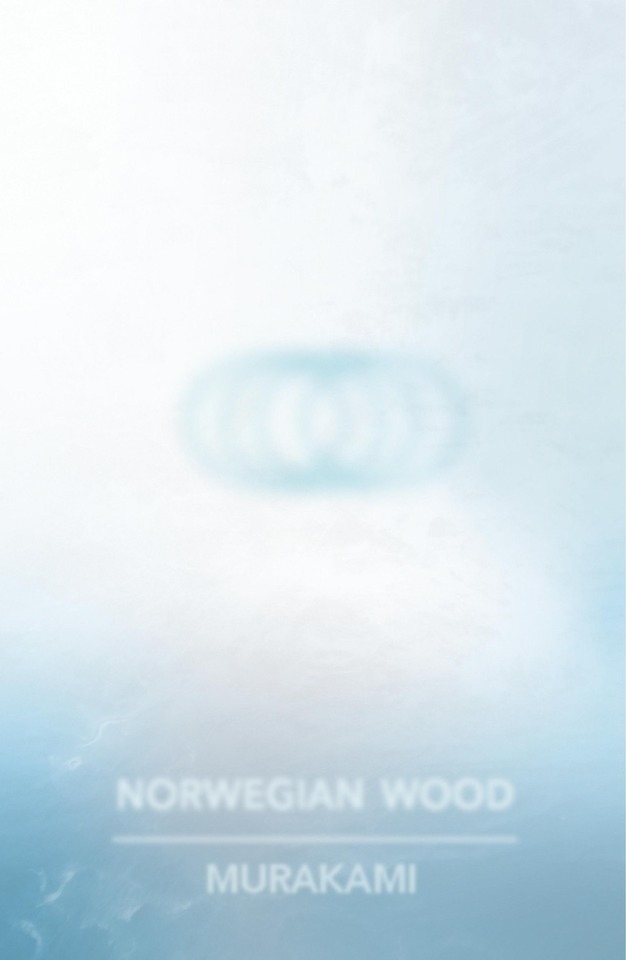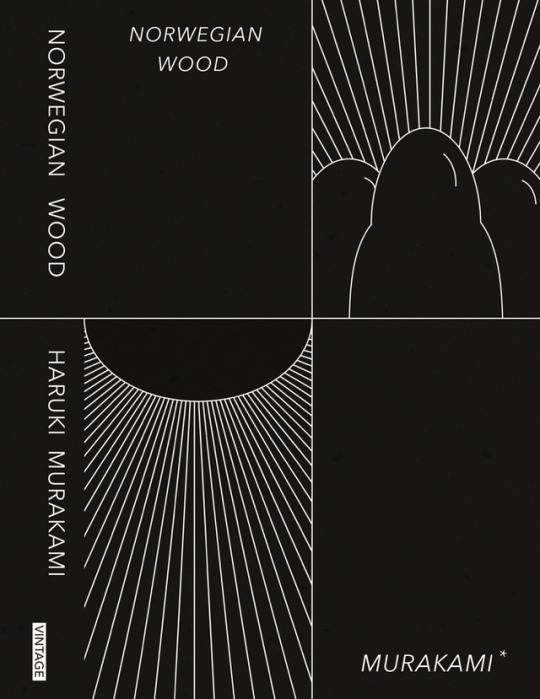Photo



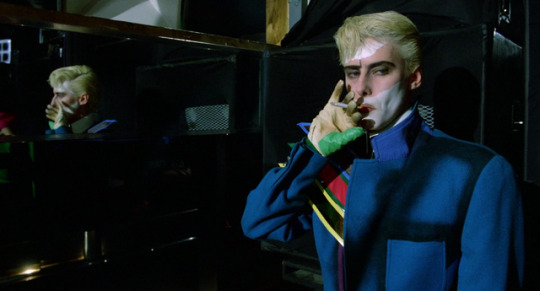

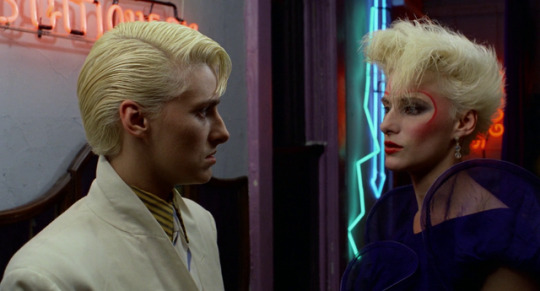


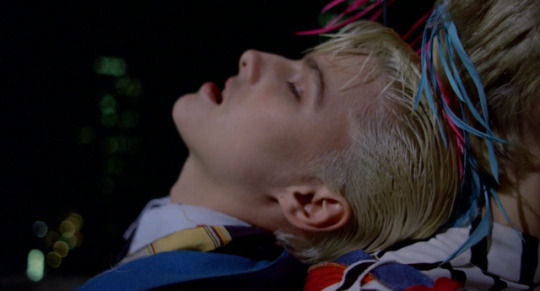
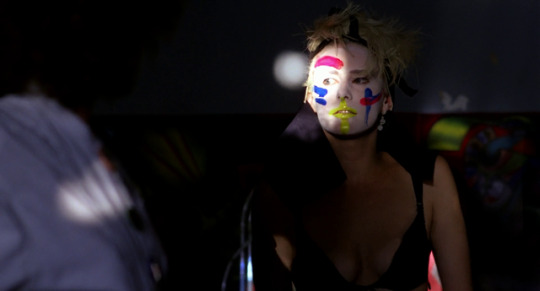
Anne Carlisle in Liquid Sky (1982) dir. Slava Tsukerman
3K notes
·
View notes
Photo

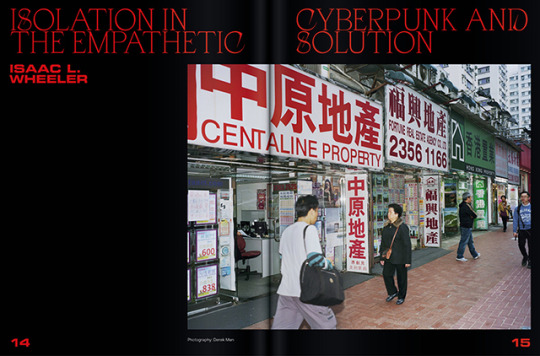
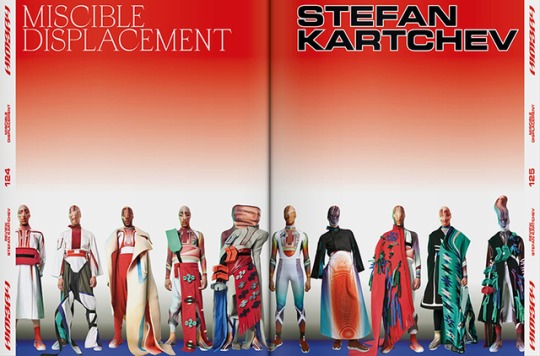
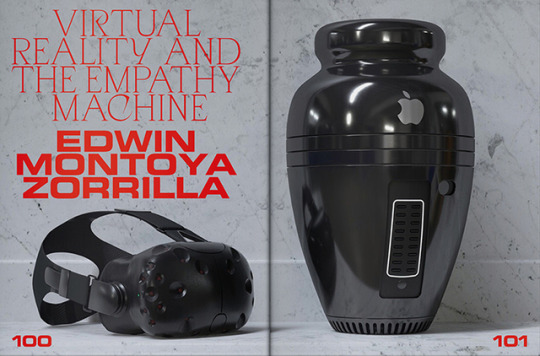


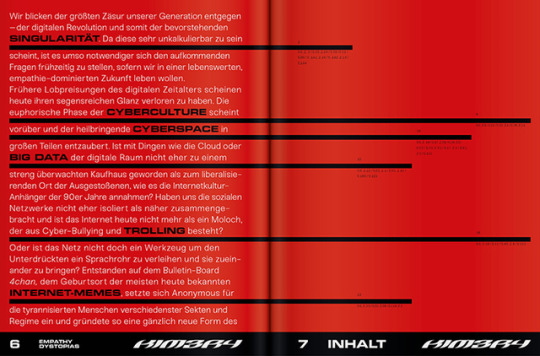
Michael Clasen - K1M3R4
“I wanted to convey a hybridisation of the digital and analog because I think this is what cyberpunk is about. I created a system where texts and pictures are marked with tags. Every tag has a mark that shows where this tag appears elsewhere. With this system I tried to break the linear structure of the printed medium,” he explains. The mock hyperlinks disrupt and unsettle the reading experience and in doing so, mimic the futurist anarchic movement Michael brings to life via the magazine.
“I think that empathy will play a major role in a future where technology takes over more and more of our lives. The digital mediums influence our ability to empathise in very ambiguous ways. Did the internet bring us closer together or has it made us more narcissistic and self-centred?” Michael asks. By deviating from established analytical frameworks, K1M3R4 is able to question what the future holds in visually engaging and insightful ways. It leaves the reader wondering whether future generations will have lower levels of empathy or whether empathy will be the salvation from a potentially dystopian future.
Essays, interviews, cultural reviews and art submissions are neatly laid out in this considered publication. “K1M3R4 was intended to be bold, loud, sharp and brave. I wanted it to have a contemporary cyberpunk-aesthetic without it being too trashy. It was important for me that it works as a magazine that transports information instead of just being a visual overload,” Michael says. The designer explains that he wanted to create the illusion of neon without using glow effects while, typographically, he contrasted organic shapes with futuristic lines to reflect the idea of the cyborg.
0 notes
Text
Polluted Beauty - Claire Matthews
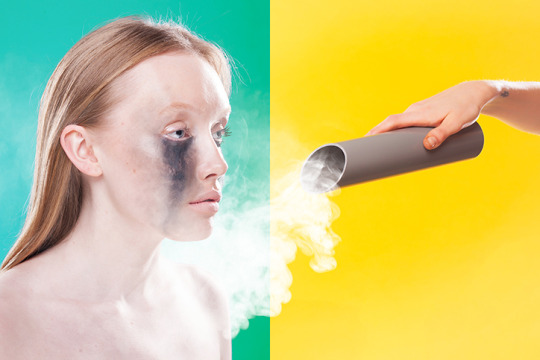
Graphic designer Claire Matthews founded independent campaign group Clean Air Now alongside Vasilisa Forbes in 2016. Clean Air Now advocate for positive environmental change in London and across the UK, through billboards, subverts, videos and street art placement.
We’re at a critical time, and many big decisions are being made by politicians and policy-makers that will undoubtably affect the planet and our livelihoods both now and for future generations.
When it comes to rallying support for environmental causes, those in the creative sphere have a unique opportunity to use their skillset to raise public awareness and help spearhead change. Despite this, the environmental campaigns that make it out to the public eye day-to-day often feel outdated, unrelatable, and targeted at those already ‘woke’ to the issue at hand.
Setting up Clean Air Now was triggered by a feeling of frustration towards this lost opportunity, particularly in engaging with a new wave of bold young activists who have the potential to make a real difference and spread awareness. In the age of the internet, echo messaging and breadth of digital design, traditional environmental activist organisations are losing out.
Despite poor air quality being linked to over 40,000 early deaths annually in the UK alone, we found the design of many NGO’s anti-pollution campaigns followed an ‘off-the-shelf’ formula and felt soft-touch and forgetful. Often using idyllic imagery of clear skies and rolling hills, some campaigns could even be mistaken for the kind of travel ad you might see on the underground, were you not to spot the call to action.
We believe we need to bridge this disconnect by creating direct, engaging and people-led environmental campaigns that mobilise and empower young people. In terms of design, this means creating visuals that are audacious, brave and challenge the status quo. The washed out, tired visuals we are used to seeing are not doing enough to inspire fresh activism.
Where’s the influential face for environmental campaigning? Young identity needs to be reflected, and here collaboration can be key. In Grime Goes Green, our first fully-fledged campaign, we worked with leading Grime artists to promote electric cars and bikes as alternative inner-city transportation. By using young influencers and creating relatable content we were able to show that supporting and making green decisions is a bold, courageous, and even cool, thing to do.
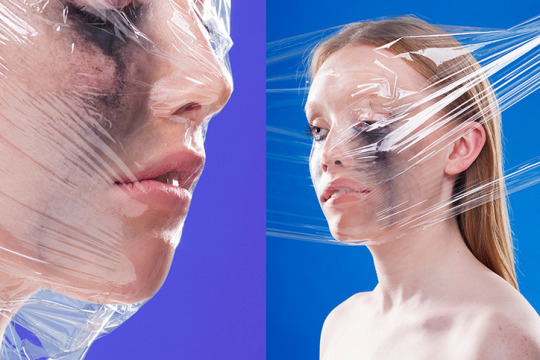
Polluted Beauty
The latest campaign, Polluted Beauty, illustrates the visible and shocking impact that dirty air has on our appearance. From blocked pores, premature ageing, loss of facial elasticity and dark circles, pollution is wreaking havoc on both our skin and hair. Our campaign aims to highlight this. By using pop-colours, fashion-led poses and bold diptychs we are visualising the invisible effects of pollution. We utilised design to make the message bold and pop without shying away from the grotesque reality of the situation.
The devastating impact of pollution is both a political and personal affair. As designers and creatives it’s important that we harness our skills to visually present activist messages. From keying into youth culture through pop-inspired ‘shareable’ imagery to putting up billboards that feature influencers and shake up the ignorable ‘norm’ of what an advertisement looks like, now — more than ever — the future of the planet lies with us. If you’re a creative, now is the time to take your art and make it activism.
1 note
·
View note
Photo
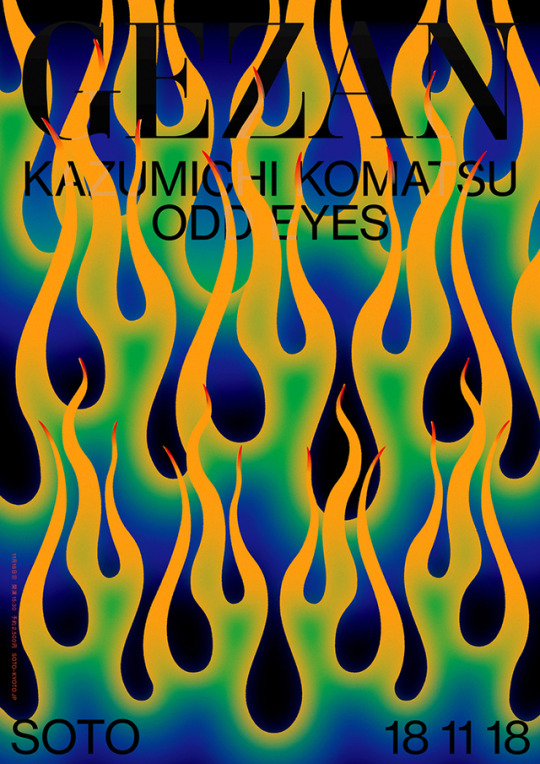


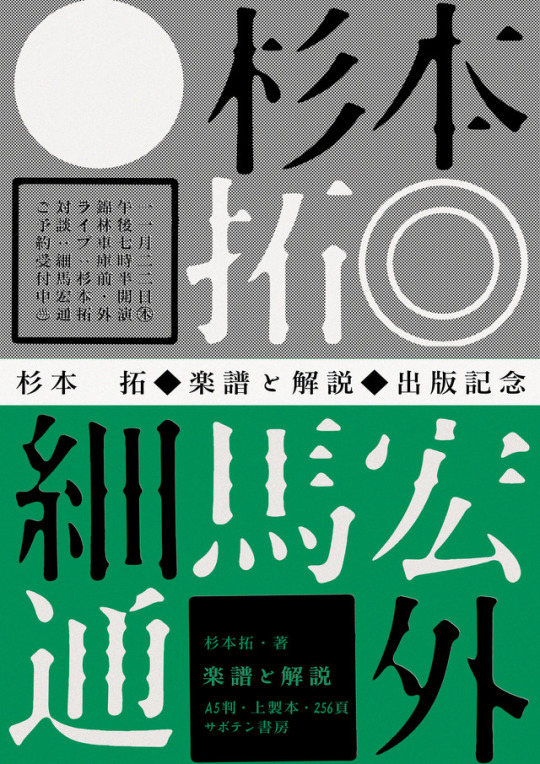

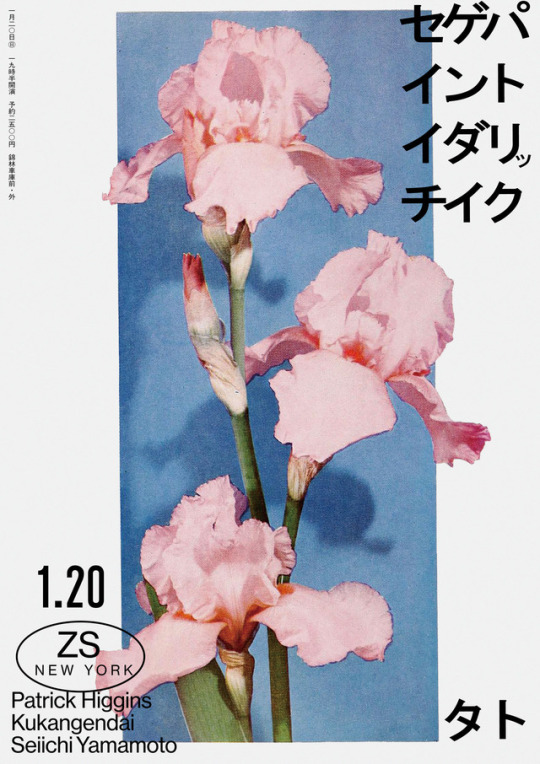

Shun Ishizuka
“I think I have a strong style but I also struggle to define it," explains the designer. “Some people find it beautiful and others think it’s ugly. Love and hate. Balance and imbalance. When I’m designing, my emotions are ambivalent as I want to create variable meanings.”
“I like classic, traditional things but I'm also interested in futuristic stuff”, says Shun, “we need to respect the cultural past but also need to go forward.” In turn, his design mixes genres of graphic design and obscures the boundaries between aesthetic schools of thought, often considering how stories and motions are composed which then informs Shun's design treatment.
1 note
·
View note
Text
Caleb Halter’s instinctual design practice produces considered

“I think in the past I was only focused on aesthetics,” Caleb tells that, “But if all you have is an aesthetic approach, that look really only serves itself, not your client or your audience. My focus now is trying to strike a balance between, yes, strong visuals and a relevant aesthetic, but also a concept that couldn’t work for anyone else.”
To ascertain what these concepts are, Caleb understates a period of research into a given topic; “trying to immerse myself in the subject as much as I can and distilling that information down, to its most singular form and then finding a striking way to express it,” he adds. When working on the artwork for Oneohtrix Point Never’s soundtrack for Good Time, this immersion included delving into behind the scenes and pre-production materials for the film.
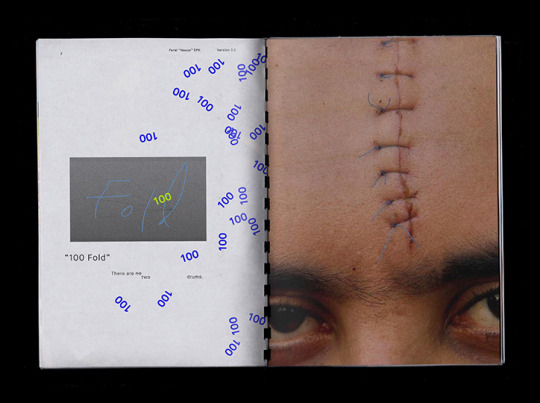
“The brief from the label was simply to design a special collector’s edition of the film score, and the only specific direction from Dan (OPN) was ‘Keep it weird. Blow my mind.’” Caleb outlines, “The whole thing was basically just Dan and me using production stills, wardrobe tests, even photos from Dan’s phone from the recording process.” The result is a cassette – a medium chosen to reflect the film’s gritty and raw nature – with a six-panel artwork wrapping around it. “I wanted each individual canvas to have impact, while hanging together within a single piece. The final artwork combines simple elements in unexpected, even crude ways – almost like an artefact you’d find in the film itself.”
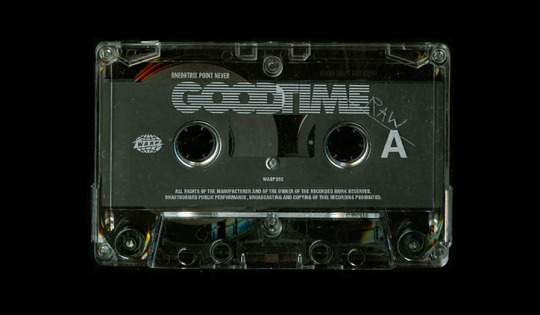
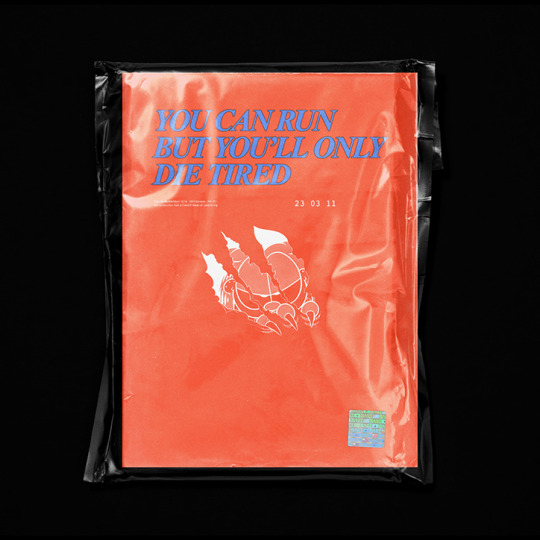
Caleb’s practice also spans to include designing material for his own musical output Feral – a place where he can take a break from design as a job, and produce visuals which are “almost like design muscle-memory”. But his commercial work is no less compelling, and often encompasses the same instinctual way of working. When recently producing visuals for the New York Times’ podcast The Daily, the entire campaign transpired from Caleb’s original sketch. “It’s difficult getting to a place where you trust your instincts, so it was really encouraging to have those instincts resonate with a client I respect as much as the Times,” he muses.
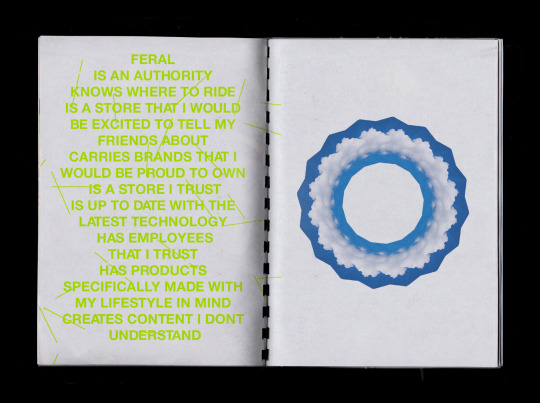
It’s this innate response to briefs which enables Caleb to produce such varying, yet always such considered work. Having learned to balance style and substance, his designs always fit, and hit, the mark. “I would say my style walks the tightrope between refined and instinctual,” he concludes, “considered without overworking things too much.”

regrets-only.com
0 notes
Text
Checking My page Below ;0 /// PC ONLY!!
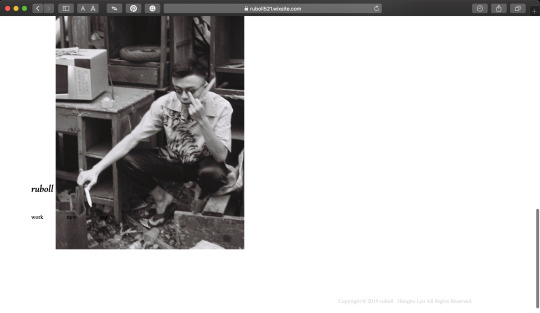
https://ruboll521.wixsite.com/ruboll
Some pages will loading slow due to large image files.plz whit it Each button connects to the relevant page. If there is no response, plz flash the page.
0 notes
Text

Movie Aesthetics/Mishima: A Life In Four Chapters
“Inspiration is just another word for problem-solving.”
DIRECTED-PAUL SCHRADER 1985
Paul Schrader’s Mishima: A Life in Four Chapters (1985), which he brought to Ebertfest in a sparkling print. Schrader is one of two American film critics who became major directors (Peter Bogdanovich is the other), and there’s little doubt that he’s the most cerebral and theoretically inclined of that group known as the Movie Brats. Even if he hadn’t written milestone screenplays (Taxi Driver, Raging Bull) and made provocative films (Blue Collar, Hard Core, Affliction), he would be remembered for his critical writing. A trailblazing essay on Joseph H. Lewis, “Notes on Film Noir,” the essay on the yakuza film, and the book Transcendental Style in Film (1972) made Schrader a distinctive voice in American film culture.
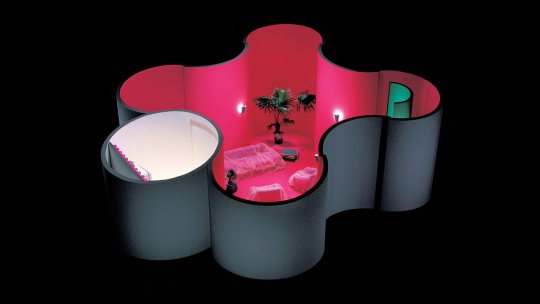
This film revels in dismantling the story structure to emphasize its themes of art, beauty, action, and identity. It startles with it’s lack of concern for conventional transitional elements and plot devices. It comes to the cliff of theatricality and leaps as far into space as it can and lands somewhere unseen and undreamed of.

On one axis, we get four chapters: Beauty, Art, Action, Harmony of Pen and Sword. On another axis, there are three interwoven strands: an account of the final day of Mishima’s life, when he seized control of a general’s office in order to address the garrison; a chronological biography, from his childhood to his adulthood; and stylized, efflorescent scenes taken from three Mishima novels. All these strands knot in the film’s final moments, when Mishima commits seppuku in the office and we see the culmination of the action shown in the novels’ tableaus. A “cross-hatched” structure, Schrader calls it.
The three strands are kept distinct through some technical markers: black and white for the biographical scenes, cinema-verite color for the 1970 attack on the garrison, and stylized color and setting for the extracts from the novels. Schrader explained that he had originally wanted to use video for the novel scenes, but his brilliant production designer Ishioka Eiko told him that the results might not be effective. Instead, she supplied designs of a dreamy radiance.
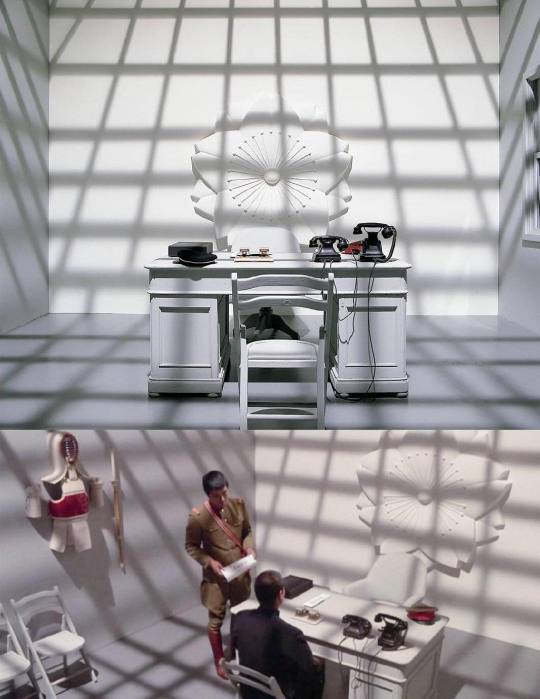
Nevertheless, I’d argue, the film has a marked trajectory. “Perfection of the life or of the art?” Yeats asked. Schrader’s Mishima wants both, together. He seeks to fuse physicality (eroticism, violence, endurance of pain) with spirituality (given as the realm of art). The emblematic image is the poem written in a splash of blood. He finally realizes that for him this fusion can come only in death, because his life has come to embody, literally incarnate, his literary themes and techniques.
Schrader’s film enacts the blending of art and life in its very imagery. At the climax, in the biographical strand Mishima climbs into a jet and the black-and-white imagery gains radiant color as he stares into the sun. The shift brings the biography up to 1970, and so provides a transition to the color footage of the writer’s last day, but it also recalls the opening credits, with the sun rising, and the closing shot of the cadet Isao about to slash himself.
The film provides a visceral and a sensuous experience, but it doesn’t carry you off on waves of emotion. It will never be popular on a massive scale, because it makes almost no concessions to what people like in biopics. But if you can adjust yourself to a solemn celebration of blood and beauty, Mishima offers unparalleled rewards.

Reading
http://international.ucla.edu/institute/article/94627 https://www.criterion.com/current/posts/4040-bergman-centennial-essential-sirk-twin-peaks-casting
0 notes
Photo

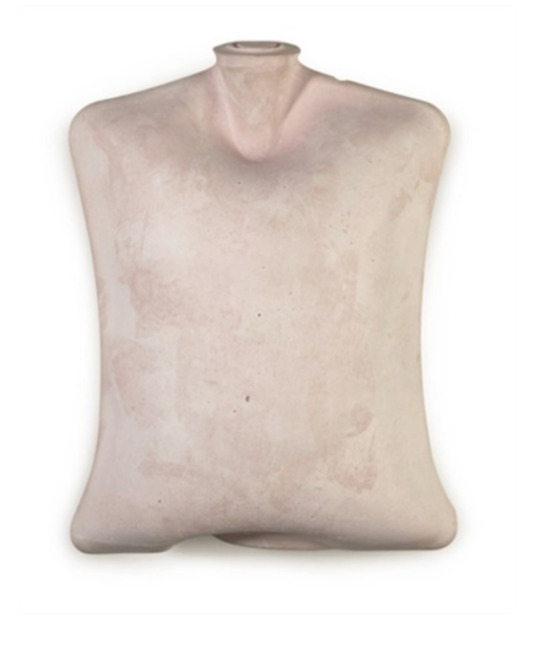
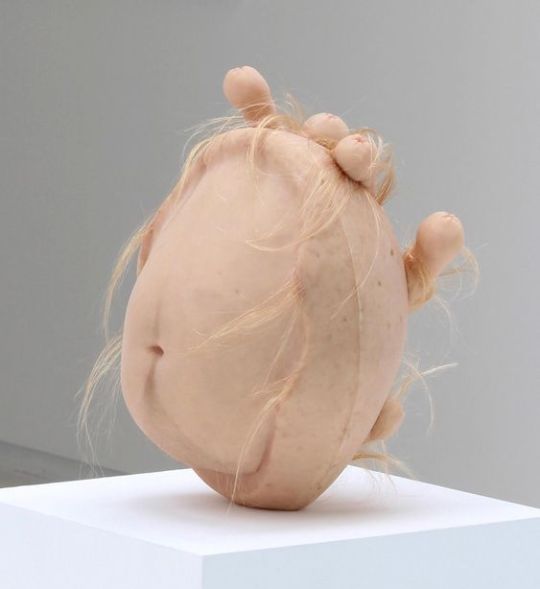
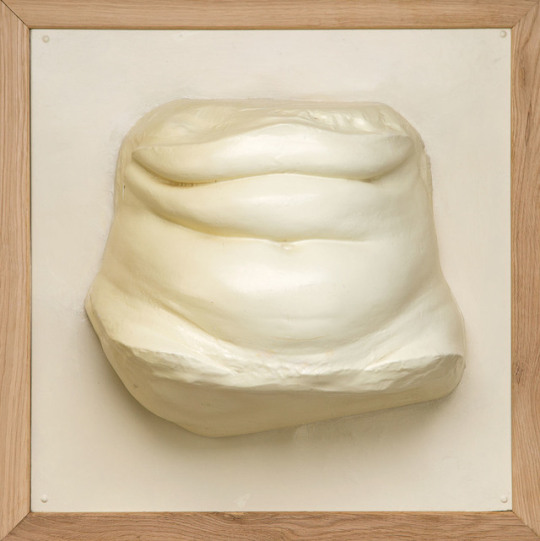
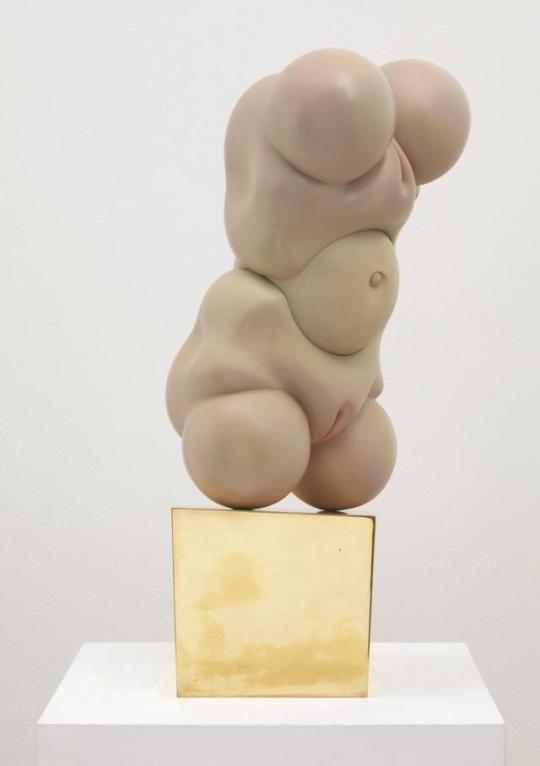
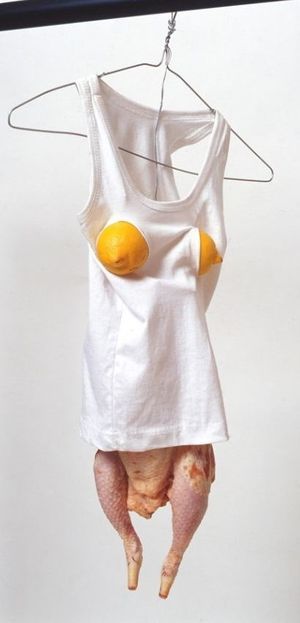


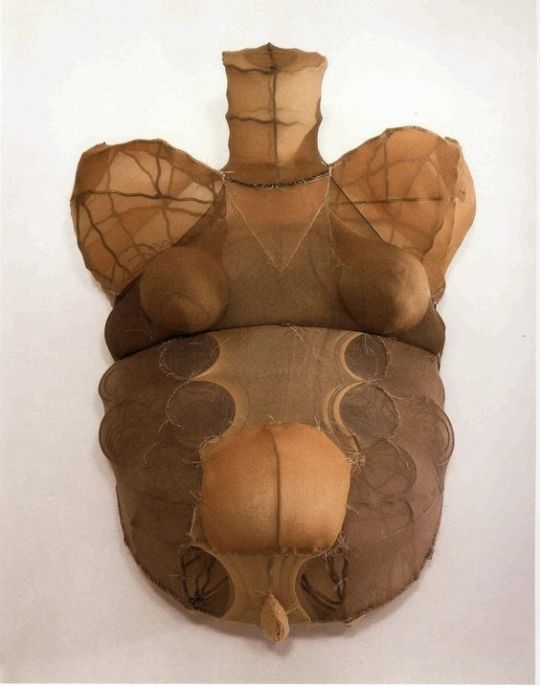
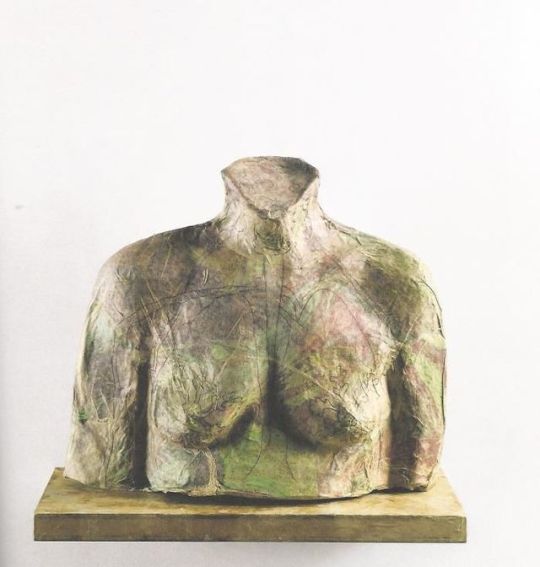
Robert Gober, Untitled (Big Torso), 1990, beeswax, pigment, human hair, ca. 24 x 18 x 11 in., Anthony Meier Fine Arts, San Francisco
Rachel Whiteread, Untitled torso , 1991, cast dental plaster, 7.6 x 22.9 x 15.2 cm (3 x 9 x 6 in)
Patricia Piccinini, Egg/Head, 2016, Silicone, human hair
Alina Szapocznikow, Ventre (“Belly”), circa 1968, repeatedly thermoformed plastic, 50 x 50 x 20 cm
Hans Bellmer, The Doll, 1936, reconstructed 1965, Painted aluminium on brass base
Sarah Lucas, Sex Baby Bed Base (detail), 2000, chicken, T-shirt, lemons, and hanger, 70 9/10 × 52 3/5 in 180 × 133.5 cm
Berlinde De Bruyckere, Muffled Cry of the Unrealisable Desire, 2009-2010 (wax wood, glass, epoxy, iron)
Tim Hawkinson, Torso, 2018, Shopping bags, urethane foam
Louise Bourgeois. Untitled 1998. Fabric and steel, 10 x 25 ½ x 18 inches.
Kiki Smith, Untitled (Upper Torso), paper mache with graphite, Nepal paper, marbelized paper, cloth, muslin, newspaper and wood, 16 by 18 by 8 ¼ in.
2K notes
·
View notes
Photo
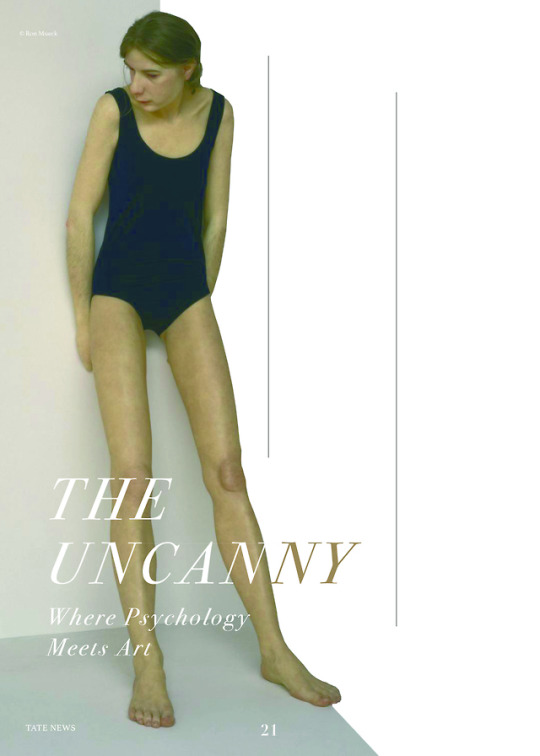

Design Sprint - Mag
Ghost 1998 is a very large sculpture of a teenage girl wearing a dark blue swimming costume. Over two metres tall, the long-legged figure seems to lean awkwardly against the gallery wall, her arms hanging down by her sides with her hands and their curled fingers touching the wall behind her. She has brown hair tied in a loose ponytail at the back of her head, and her gaze is directed downwards and to her right. The sculpture is completed in a highly detailed and realistic manner, with small spots visible on the teenager’s face and light hairs on her arms and upper lip. It is displayed on a large white plinth and is affixed to the gallery wall by an aluminium hook located at the base of the figure’s spine.
https://www.tate.org.uk/art/artworks/mueck-ghost-t07445
1 note
·
View note
Text
Contextual Lecture - Designing for the Anthropocene
The Anthropocene proposed the term for the present geological epoch from the time of the industrial revolution onwards during which humanity has begun to have a significant impact on the environment
Borenstein, Seth (2014)
Why should we care about climate change?
Around the world, scientists are tracking storms that are bigger, heat that is more intense and droughts that last longer.
Global warming changes climate
Changes breed intense weather
The threat is global and urgent
Where are we NOW/ Anthropos- Human Cene- Geological Epoch
Chthulucene And tentacular thinking Tentacularity
Thinking with the inhabitants of the world, creatures of all kinds, human and non-human, even mushrooms, we are all wayfarers, moving from place to place.
MAN (2012) Steve Cutts
youtube
Animated Short Film Perfectly Captures Man’s Destructive Nature, All In The Name Of Development.This is not some existential angst talking, nor is this a hippie rant; I'm seriously asking. We've almost exhausted all the planet's resources, killed more animals than we needed and now we're making the planet uninhabitable for future generations.
What shapes how we see the world?
Naked eye - Aeroplane(Tool) - Remotely Technology
OH HEY MARS!
Space enthusiasts speak of humanity being saved by interplanetary colonization, but it wouldn’t be the whole of humanity going to Mars
‘While I would like us to explore Mars more I think the only thing we’ve demonstrated is that we’re very good at destroying the habitability of Earth, rather than improving the habitability of a completely alien world. The idea that Mars will somehow save us from the decisions we have made here is a false one, and it’s a little like saying you are going to live in the lifeboat when even lifeboats need somewhere to land.’
Walkowicz, L. in Lo and Behold: Reveries of the Connected World. (2016). [film] Directed by W. Herzog.
Designer - Environment
Architecture Designers vs. Climate
ChangeLeading architects, designers, and urban planners are devising plans to help mitigate greenhouse gas emissions. Are they our best hope for a brighter future?
Like a growing number of her peers, architect Stephanie Horowitz believes in the design community’s inherent responsibility to address climate issues.
“For others, we try to educate them and be upfront about it. Sometimes we’re going to convince people; sometimes we’re not,” she admits, “but the onus is on us to make the case.” Aamodt focuses on quality over quantity and designs built with clean, healthy materials and fair labor.
https://www.architecturaldigest.com/story/designers-architects-take-on-climate-change
Fashion and Climate Change
....many conscious fashion brands, which often rely heavily on natural materials like cotton or leather to avoid the environmental problems associated with synthetics. But Bédat noted that greenhouse emissions, while significant, aren't the only consideration when it comes to the environment — there are also things like microfabric, or tiny strands of synthetic materials, that can leach into and pollute the ocean when synthetic clothing is washed.It's a serious problem that the industry is looking for ways to address.
Rothschild noted that H&M recently began using a fabric made of recycled ocean plastic, and Aden suggested that getting together with other stakeholders, like washing machine manufacturers, could lead to new solutions for keeping those fibers out of the water. And he also notes that both big business and individual consumer education is important. Something as simple as using cold water rather than hot in the washing machine has a sizable impact on the emissions involved in the lifespan of a garment, because the energy used to heat water is emissions-intensive. Thankfully, that's the kind of switch that's easy for most consumers to make once they learn the positive impact of doing so.
https://fashionista.com/2017/09/fashion-industry-greenhouse-gas-climate-change-sustainability
Stella McCartney's latest campaign was unveiled. Shot at a landfill by Harley Weir in collaboration with artist Urs Fisher, the images explore themes which are central the designer's work: waste and consumption. As environmental issues enter conversations around fashion at an increasing rate, we've decided to take a look at the designers doing their bit to help the cause... (Link
http://www.thelovemagazine.co.uk/posts/8217/five-fashion-designers-making-environmental-statements
Limbic Resonance
… refers to the energetic exchange that happens between two people who are interacting in a caring and safe relationship. Their interaction stimulates the release of certain neurochemicals in the limbic region of the brain.
Cash, H. (2011). The Online Social Experience and Limbic Resonance. [online] Psychology Today.
0 notes
Text
Reflection/ The country of the self
EP1 Happiness Machine
The primitive driving force of man is indeed one of the core of Freud. How to mobilize people's subconscious is the basic means to control others.
Propaganda is not good, we are Council of Public Relations; against Smoking Women? We are symbols of Torches of Freedom. There's a way for people to play with their hearts. Women smoke = more powerful and independent.
Transform from needs to Desires, Man's Disires must overshadow his needs. Change from a demand-oriented society to a Desire-oriented society, stimulate domestic demand and stimulate consumer desire to cope with overcapacity, and also promote cultural leadership. This is true in countries with a little money all over the world. Americans are really strong. Make desire, make demand. Our people don't know what they need and what they want, so PR has contributed to this. If all of these efforts are devoted to research and don't know what will happen, then I want to laugh. The bitter things at least now seem to be anti-animal, not endangering the survival and reproduction, who would like to suffer.
Expressing oneself, in fact, does not seem to be a false proposition. The general public is bound by the idea of expressing themselves, but do they really express themselves? Or is it self-deceiving consumption? Democracy, it seems, is also a false proposition. Why entrust the fate of all human beings to all foolish human beings? At most, it's a democratic representative who can make a living.
EP2 The Engineering of Consent
The human heart is impulsive, irrational, selfish, dangerous desires and animal instincts. To what extent can we consciously shape and change our subconscious mind? And when our government / power holders / policymakers are trying to change the way we are shaped, to what extent is it not called The Beautiful New World? I don't believe that the primitive driving force of human nature is evil. The so-called human nature is distorted by social constraints. Can't it be seen in the chimpanzee population and animal behavior among various animal groups? Humanity itself is not for the social service, but for the individual gene reproduction service, how to ask instinct to do idealistic good and evil?
Edward Bernays'propaganda strategy is still in use today. The usual excuses of Soviet/Communist control/aggression, American democracy/American cultural values/American national security being threatened have been applied almost invariably since the cold war. To subvert the regimes of other countries is not beneficial to the interests of the United States once there is one thing in other countries. Big Brother wasn't like that in 1984? Freud, George Orwell, meet here. Brainwashing, which appears in various systems, is often the most successful person/country. The greatest success in the world is brainwashing. Man is vulnerable as an individual, and man as a group is more vulnerable. If convincing is achieved, how to construct other people's recognition, thus shaping other people's inner values and orientations, this is engineering of consent.
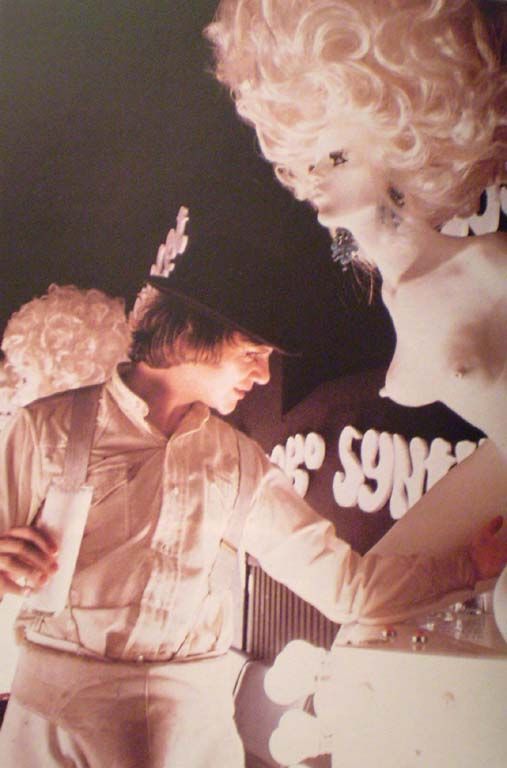
Dr. Ewen Cameron's experiment is actually "A Clockwork Orange", clearing - implanting - New humans. But is it so easy and simple for people to think? Of course, the colonization of cultural dissemination, as you can see for decades, has transformed the United States into a true lighthouse nation.
Contextual Lecture Politics of the Image related.
youtube
0 notes
Text
Contextual Lecture - Politics of the Image
Beyond the Aestheticization of the Politics
In the 20th century, aestheticization of the politics was heavily criticized as a try to conceive regular practices of life and societal behavior as innately artistic, and to introduce politic values to art, by structuring it as an art form in order to normalize emancipatory or revolutionary practices and enclose it to the autonomous field of art. This was the concept first coined by Walter Benjamin and later developed in the thought of Frankfurt School. It was also the philosophical reaction to the appropriation of the art by the Fascist regimes in Europe. In the light of this theory, the polar opposite of these practices of aestheticization would be the term of the politicization of aesthetics – a kind of revolutionary praxis of rethinking the depoliticized field of art production and adding the wider political or rather emancipatory character to the art work.
Liberation of Art
The main idea behind the liberating art from the corrupting politic movements such as Fascism, Nazism or any other reductive and destructive social agenda, is to reclaim its autonomy once again. For any artistic work is crucial to be free from the function and especially transgressing its subordinate position when art is reduced to the political tool of ruling mechanism. The very act of negation or disagreement with the negative or harmful within the politics is crucial for the understanding the core value of the politically engaged art in whole. As artistic practice is the act of creation, intervention into the body of real world, art, as a form of social action, is a very mighty tool of the political imagination, by (re)presenting the world, not in a sudden, but in some further or better condition.
Political Role of Art
When questioning the role of art today, we must be aware of the illusive borders between art and life, art and media, art and society, as well as art and activism. In so many cases of artist works, it is hard to formulate not just the notion of art but even its position within the society. In contemporary societies, it is important to abandon the romantic visions of art’s mission, but at the same time to insist on the constant questioning dominant politics within the art, maintaining and fight for the inherent artistic freedom of speech and expression. The role of political art has always been crucial since it is one of rare uncorrupted forces of emancipatory action and battlefield of the crucial dispute what is and what could be beauty, truth, and the good.
Influential Political Art Pieces
In the course of art history there are many examples art was the crucial reflection of political context. Moreover, analyzing and disputing the art pieces, we learn about life and circumstances from which we are far away in space or time. The art pieces were critical or undue to the dominant values of its time, we often understood as a political avant-garde, the announcement of the political changes that followed. Here, we would like to present different politically engaged art works, trying to display the wide specter of political action within the field of art, without pitfall of losing the art qualities and becoming the political agenda itself. The selection we made addresses the questions of wars and political conflicts, rise of fascism, revolution and social change, as well as human rights activism, feminish, autonomy of art or various problems of artistic production and work itself. Methodologies, media or artistic strategies are numerous and proving that politically engaged art is not reducible to propaganda.
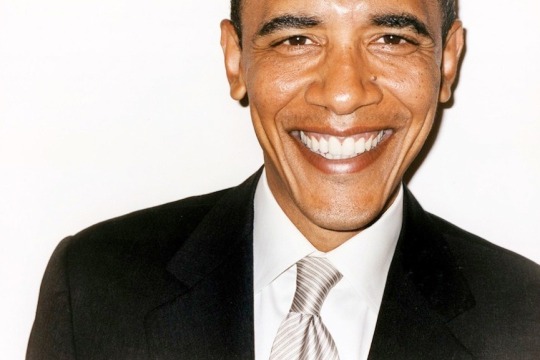
Terry Richardson - Portraits of President Barack Obama from 2012
As a first African-American US president, Barack Obama was the endless source of inspiration for artists, who frequently inscribe their emancipatory politics into his figure. In his series of portraits, Terry Richardson tried the counter strategy – to liberate the clebe face of the president from the symbolic and to fit his appearance into own pop culture aesthetics.
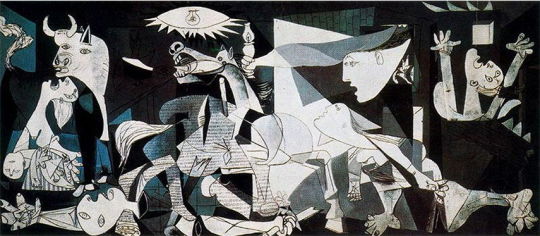
Pablo Picasso – Guernica, 1937
Interpretations of Guernica vary widely and contradict one another. This extends, for example, to the mural's two dominant elements: the bull and the horse. Art historian Patricia Failing said, "The bull and the horse are important characters in Spanish culture. Picasso himself certainly used these characters to play many different roles over time. This has made the task of interpreting the specific meaning of the bull and the horse very tough. Their relationship is a kind of ballet that was conceived in a variety of ways throughout Picasso's career."
Some critics warn against trusting the political message in Guernica. For instance the rampaging bull, a major motif of destruction here, has previouse figured, whether as a bull or Minotaur, as Picasso' ego. However, in this instance the bull probably represents the onslaught of Fascism. Picasso said it meant brutality and darkness, presumably reminiscent of his prophetic. He also stated that the horse represented the people of Guernica.
Image is nothing
youtube
“Image is nothing. Thirst is everything. Obey your thirst,” one of Sprite’s early repositioning taglines from Lintas & Partners, served as a sly wink at the role the brand’s ads played in reviving its fortunes. Image, as it turns out, is everything.
Guy Debord – Society of the Spectacle
George Orwell – Politics and the English Language
Marshall Mcluhan – The Medium is the Message
Peter Oborne – The Triumph of the Political Class
Orthodoxy by GK Chesterton
Fractured Times by Eric Hobsbawm
0 notes
Text
PARALLEL SPACE - Mellon Zhou
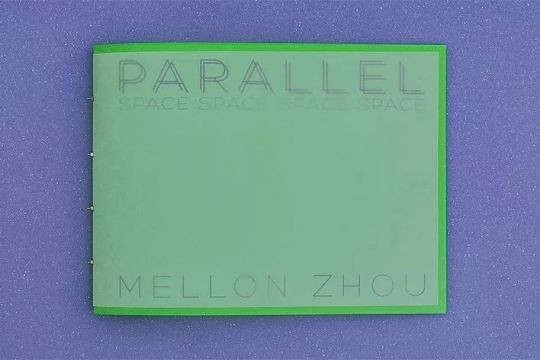
‘A person's image has emotions and feelings, I think an object is also, but it may be given by people, is imagination and fiction. However, in addition to the subjective feelings of human beings, objects themselves have their own attributes and characteristics. The contradictions between these two states may be closely related or parallel to each other.’
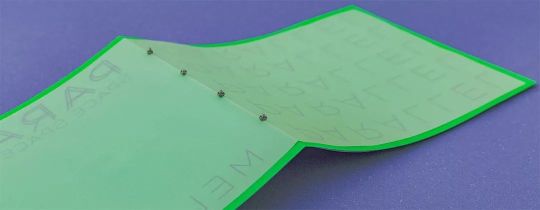
Parallel Space is a very special binding. It uses screws, which reminds me of the screw connecting the foot of the glasses and the glasses. Using screw will make the book more like an object, suitable for the content of the book.

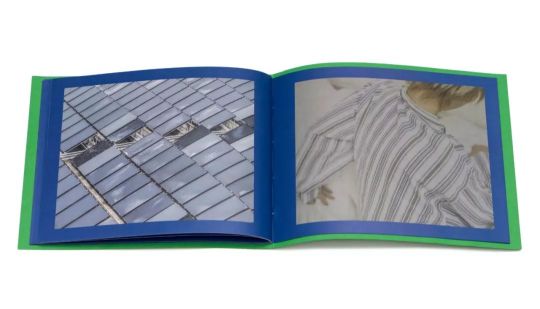
‘Blue was mainly used for zine's design. At that time, I thought it would make the photos more uniform in the same "space", and most of the photos in the book were green, so I chose a close color match. I found that the use of blue undertones weakened the independence of the photograph and could not be seen alone. Especially when the two pictures are put together, the blue background color is very uniform, forcing the readers to connect the two pictures, which weakens the space of independent imagination.’
Mellon Zhou - China-based https://cargocollective.com/mellonzhou
0 notes
